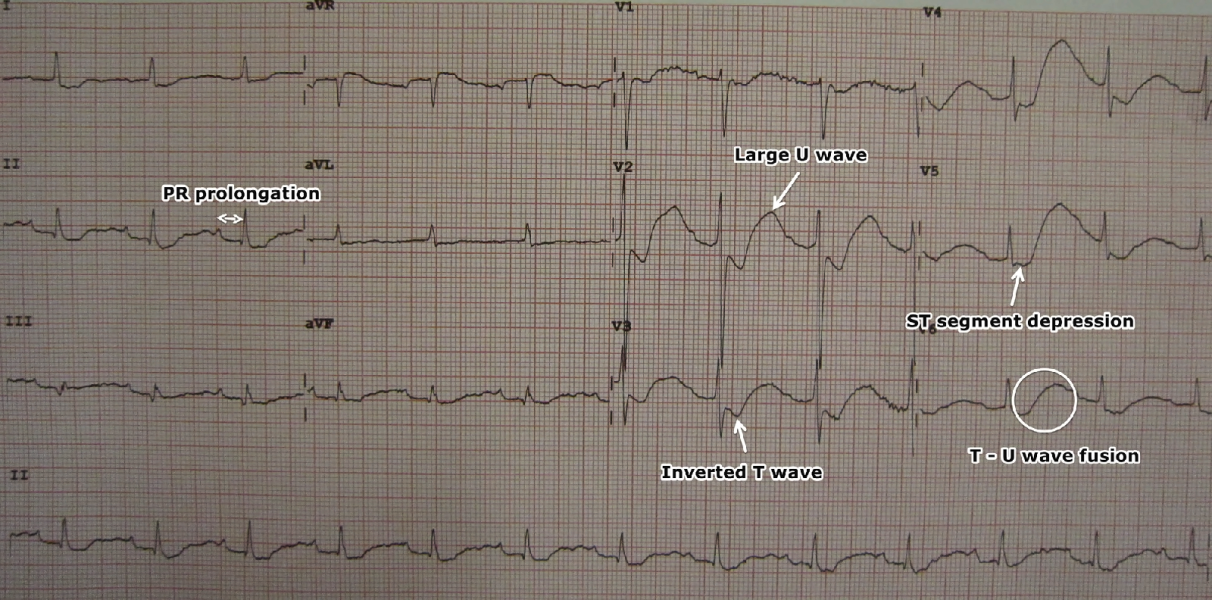|
|
| (82 intermediate revisions by 3 users not shown) |
| Line 1: |
Line 1: |
| __NOTOC__
| | ==pic== |
| {{Whipple's disease}} | | {| |
| {{CMG}}; {{AE}}
| | |[[image:LowKECG.png|thumb|700px|center|An ECG in a person with a potassium level of 1.1 showing the classical ECG changes of ST segment depression, inverted T waves, large U waves, and a slightly prolonged PR interval. By James Heilman, MD - Own work, CC BY-SA 3.0]] |
| | |} |
| | <br style="clear:left" /> |
|
| |
|
| ==Overview==
| | [[image:LowKECG.png|thumb|700px|right|An ECG in a person with a potassium level of 1.1 showing the classical ECG changes of ST segment depression, inverted T waves, large U waves, and a slightly prolonged PR interval. By James Heilman, MD - Own work, CC BY-SA 3.0]] |
| [Pathogen name] is usually transmitted via the [transmission route] route to the human host. | | <br style="clear:left" /> |
| Following transmission/ingestion, the [pathogen] uses the [entry site] to invade the [cell name] cell.
| |
| [Disease or malignancy name] arises from [cell name]s, which are [cell type] cells that are normally involved in [function of cells].
| |
| The progression to [disease name] usually involves the [molecular pathway].
| |
| The pathophysiology of [disease/malignancy] depends on the histological subtype.
| |
|
| |
|
| ==Pathophysiology==
| | {{#ev:youtube|7TWu0_Gklzo}} |
|
| |
|
| ===Pathogenesis=== | | ==Table== |
| | | {| |
| *Whipple's disease is a rare bacterial systemic infection caused by Tropheryma whipplei.<ref name="pmid18291339">{{cite journal |vauthors=Schneider T, Moos V, Loddenkemper C, Marth T, Fenollar F, Raoult D |title=Whipple's disease: new aspects of pathogenesis and treatment |journal=Lancet Infect Dis |volume=8 |issue=3 |pages=179–90 |year=2008 |pmid=18291339 |doi=10.1016/S1473-3099(08)70042-2 |url=}}</ref>
| | ! align="center" style="background:#4479BA; color: #FFFFFF;" + |Complications |
| *Tropheryma whipplei is a periodic acid-Schiff stain positive, gram-positive bacillus of actinomycetes family.<ref name="SchwartzmanSchwartzman2013">{{cite journal|last1=Schwartzman|first1=Sergio|last2=Schwartzman|first2=Monica|title=Whipple's Disease|journal=Rheumatic Disease Clinics of North America|volume=39|issue=2|year=2013|pages=313–321|issn=0889857X|doi=10.1016/j.rdc.2013.03.005}}</ref>
| | ! align="center" style="background:#4479BA; color: #FFFFFF;" + |Polymyositis |
| * The bacteria lives in soil and wastewater. Farmers and everyone who has any contact with contaminated soil and water are in high risk of the infection.
| | ! align="center" style="background:#4479BA; color: #FFFFFF;" + |Dermatomyositis |
| *It is transmitted through oro-oral and feco-oral routes. The poor sanitation is associated with T. whipplei infection. <ref name="KeitaBrouqui2013">{{cite journal|last1=Keita|first1=Alpha Kabinet|last2=Brouqui|first2=Philippe|last3=Badiaga|first3=Sékéné|last4=Benkouiten|first4=Samir|last5=Ratmanov|first5=Pavel|last6=Raoult|first6=Didier|last7=Fenollar|first7=Florence|title=Tropheryma whipplei prevalence strongly suggests human transmission in homeless shelters|journal=International Journal of Infectious Diseases|volume=17|issue=1|year=2013|pages=e67–e68|issn=12019712|doi=10.1016/j.ijid.2012.05.1033}}</ref>
| | |- |
| *It is believed that human being is the only reservoir for this bacteria.
| | ! align="center" style="background:#DCDCDC;" + |[[Cancer|Malignancy]] |
| *It invades primarily intestines and then every other organ including the heart, brain, joints, skin, lungs and the eyes.
| | | align="left" style="background:#F5F5F5;" + | |
| * Tropheryma whipplei infection has four different manifestations: acute infection, the classic Whipple’s disease, asymptomatic carrier state, and localized chronic infection.<ref name="Marth2009">{{cite journal|last1=Marth|first1=Thomas|title=New Insights into Whipple’s Disease – A Rare Intestinal Inflammatory Disorder|journal=Digestive Diseases|volume=27|issue=4|year=2009|pages=494–501|issn=1421-9875|doi=10.1159/000233288}}</ref> <ref name="StreetDonoghue1999">{{cite journal|last1=Street|first1=Sara|last2=Donoghue|first2=Helen D|last3=Neild|first3=GH|title=Tropheryma whippelii DNA in saliva of healthy people|journal=The Lancet|volume=354|issue=9185|year=1999|pages=1178–1179|issn=01406736|doi=10.1016/S0140-6736(99)03065-2}}</ref>
| | *[[Lung]] |
| * It is believed that host immunologic response to the microorganism plays an important role on the clinical manifestation of the disease.<ref name="pmid8903578">{{cite journal |vauthors=Marth T, Strober W |title=Whipple's disease |journal=Semin. Gastrointest. Dis. |volume=7 |issue=1 |pages=41–8 |year=1996 |pmid=8903578 |doi= |url=}}</ref>
| | | align="center" style="background:#F5F5F5;" + | |
| | | *[[Lung]] |
| ==Genetics==
| | |} |
| *[Disease name] is transmitted in [mode of genetic transmission] pattern.
| |
| *Genes involved in the pathogenesis of [disease name] include [gene1], [gene2], and [gene3].
| |
| *The development of [disease name] is the result of multiple genetic mutations.
| |
| ==Associated Conditions== | |
| The most important conditions associated with Whipple's disease include:
| |
| * HLA-B27 individuals: | |
| * Defective T-cell immunity:
| |
| | |
| ==Gross Pathology==
| |
| *On gross pathology, [feature1], [feature2], and [feature3] are characteristic findings of [disease name].
| |
| | |
| ==Microscopic Pathology==
| |
| *On microscopic histopathological analysis, PAS-positive macrophages in the lamina propria containing non-acid-fast gram-positive bacilli are characteristic findings of Whipple's disease.<ref name="SchneiderMoos2008">{{cite journal|last1=Schneider|first1=Thomas|last2=Moos|first2=Verena|last3=Loddenkemper|first3=Christoph|last4=Marth|first4=Thomas|last5=Fenollar|first5=Florence|last6=Raoult|first6=Didier|title=Whipple's disease: new aspects of pathogenesis and treatment|journal=The Lancet Infectious Diseases|volume=8|issue=3|year=2008|pages=179–190|issn=14733099|doi=10.1016/S1473-3099(08)70042-2}}</ref>
| |
| | |
| The images show the characteristic feature of Whipple's disease; foamy macrophages are present in the lamina propria.
| |
| | |
| <gallery align="left">
| |
| Image:Whipple disease low mag.jpg| Low magnification micrograph of Whipple's disease. H&E stain. Duodenal biopsy. By Nephron (Own work)<ref> CC BY-SA 3.0, https://commons.wikimedia.org/w/index.php?curid=15357443</ref>
| |
| Image:Whipple disease - intermed mag.jpg| Intermediate magnification micrograph of Whipple's disease. H&E stain. Duodenal biopsy. By Nephron (Own work)<ref> CC BY-SA 3.0, https://commons.wikimedia.org/w/index.php?curid=15357450</ref>
| |
| Image:Whipple disease high mag.jpg| High magnification micrograph of Whipple's disease. H&E stain. Duodenal biopsy. By Nephron (Own work)<ref> CC BY-SA 3.0, https://commons.wikimedia.org/w/index.php?curid=15357481</ref>
| |
| Image:Whipple disease very high mag.jpg| Very high magnification micrograph of Whipple's disease. H&E stain. Duodenal biopsy. By Nephron (Own work)<ref> CC BY-SA 3.0, https://commons.wikimedia.org/w/index.php?curid=15357462</ref>
| |
| </gallery>
| |
| | |
| ==References==
| |
| {{Reflist|2}}
| |
| | |
| {{WH}}
| |
| {{WS}}
| |
